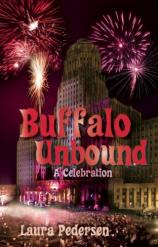Buffalo Unbound: A Celebration
Review
Buffalo Unbound: A Celebration
Laura Pedersen obviously adores Buffalo, the city she grew up
in, and she's not one bit shy about singing its praises. At the
same time, she ably skewers its idiosyncrasies, colorful characters
and general oddity in a hilariously understated comic patter.
Pedersen, who once traded on Wall Street, was a long-time
subscriber to Forbes magazine until they included Buffalo
on their list of America's Ten Most Miserable Cities. Offended, she
cancelled her subscription and wondered why Forbes didn't
dwell on her city's architectural wonders, art galleries, theaters,
museums and restaurants instead of its dwindling population and
over-abundant snowfall.
An energetic writing style and ebullient humor leaven the
results of what must have been intensive research, which yields a
bevy of Buffalocentric statistics about the history of the area,
storms, the school system, expressways, churches and unusual
architecture. While some readers will be enthralled with these
facts, others are more likely to find BUFFALO UNBOUND to be most
fascinating when Pedersen describes the many eccentric characters
in the city's history. For example, Elbert Hubbard moved to Buffalo
in 1880, eventually founding the "Roycroft movement," a community
of workers, great thinkers and artists who subscribed to Hubbard's
theories on morals, politics and spirituality. His Roycroft Press
made furniture, metalwork, leather goods and books. Hubbard wore a
Stetson hat, leather vest with gold nugget buttons, spurs and a
cape, along with long hair and a waist-long beard. His teachings
influenced American architecture and attracted well-known
followers, such as Thomas Edison, John Muir and Mark Twain.
Architect Frank Lloyd Wright was another fascinating character,
who owned five of his houses in Buffalo. Pedersen wryly notes that
when you see a mention of these, it's often in conjunction with the
word "restoration" since "…his engineering left a bit to be
desired, such as firm foundations, waterproof roofs, and all those
other tiny touches that not only make a house a home, but also keep
a building standing upright." Meanwhile, Wright's personal story
rivals the bad-boy celebrity sagas of modern times.
While many stories are hilarious and/or bizarre, a few are
thought-provoking tragedies. In 1954, a terrible fire devastated
Cleveland Hill Elementary School in a suburb near Buffalo. It took
15 lives and ultimately resulted in changes in school design and
emergency preparedness that has drastically reduced fatal school
fires in the United States.
Thanks to being geographically close to Canada, coupled with
Prohibition in the U.S., organized crime thrived in Buffalo. The
Mafia bootlegged liquor from Canada into Buffalo at the rate of
more than a thousand cases crossing the border daily. From that
start, the Mafia expanded operations to include gambling,
bookmaking, construction, loan-sharking, and much more. The end of
Prohibition didn't end organized crime's continuing financial
success. Pedersen muses that today some of their businesses have
actually become legitimate: "…much like the Buffalo winters,
the Buffalo Mafia is not what it once was."
Although rife with in-jokes for Buffalo locals, making it a
must-read for East Coasters, BUFFALO UNBOUND abounds with
entertainment (along with many riveting facts) for those who have
never experienced the area firsthand. Pedersen's essays are love
letters to her favorite city --- seemingly penned by a cross
between anthropologist Margaret Mead and the likes of Dave
Barry.
Reviewed by Terry Miller Shannon on January 5, 2011
Buffalo Unbound: A Celebration
- Publication Date: September 21, 2010
- Genres: History, Nonfiction
- Paperback: 196 pages
- Publisher: Fulcrum Publishing
- ISBN-10: 1555917356
- ISBN-13: 9781555917357





